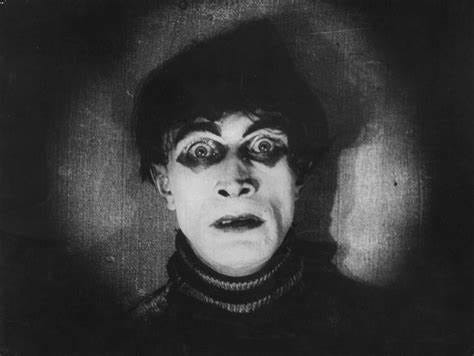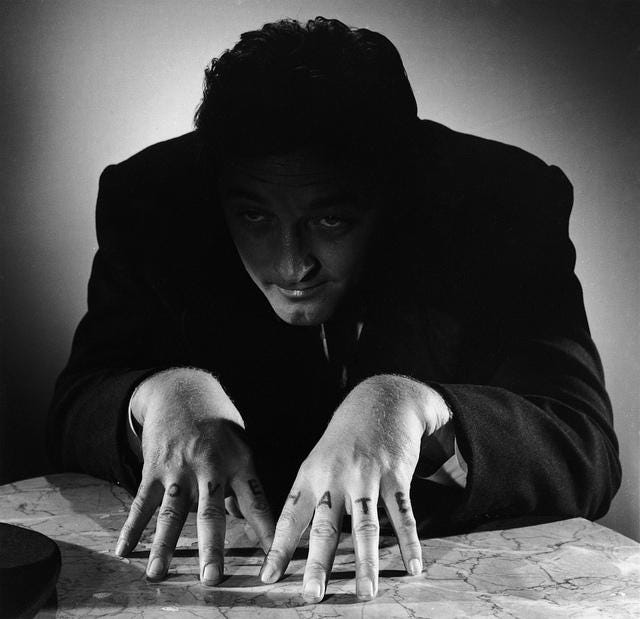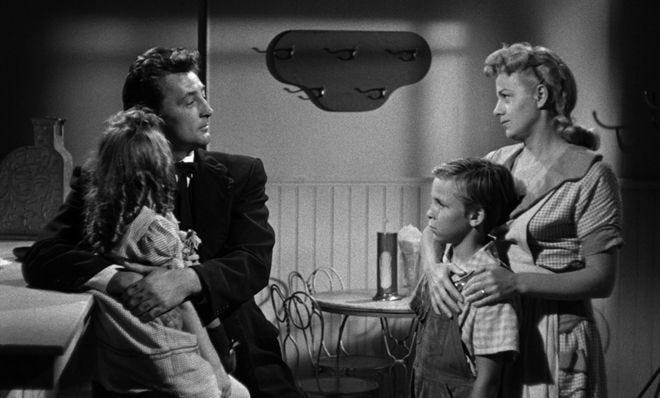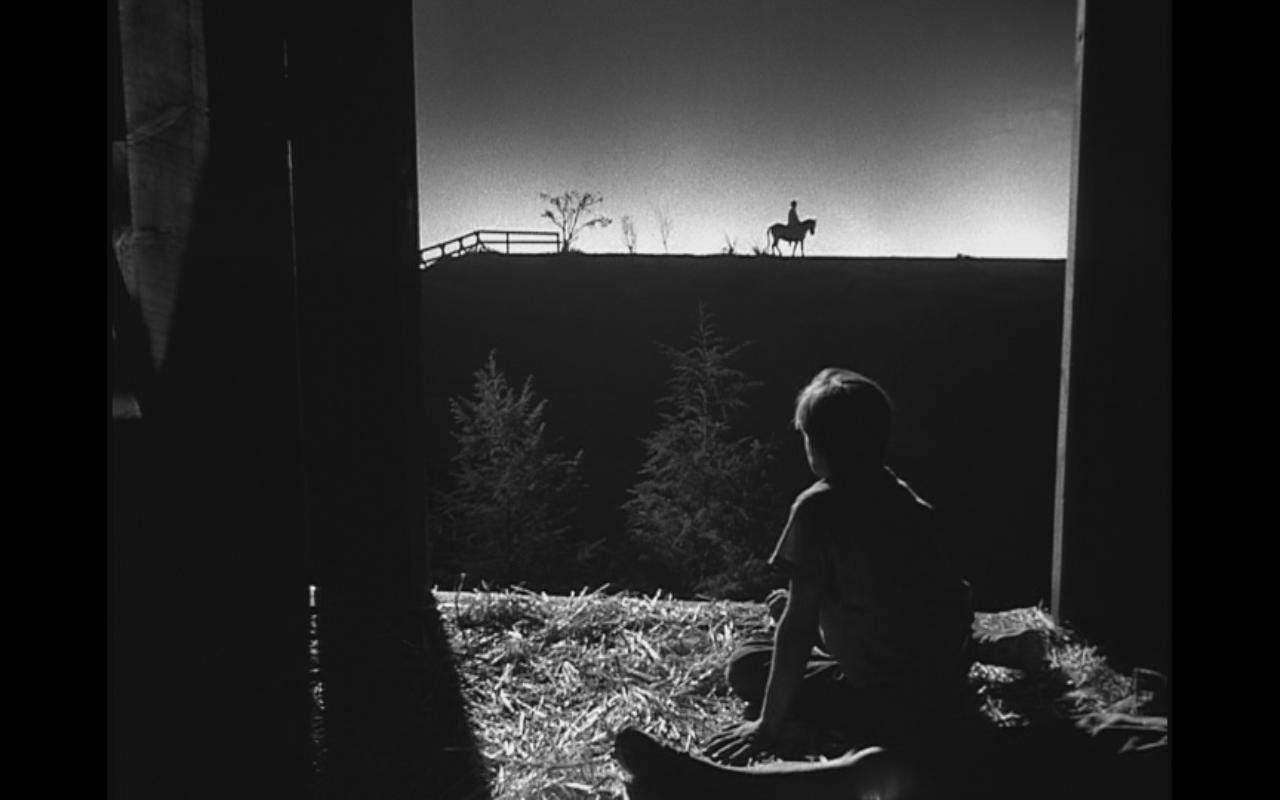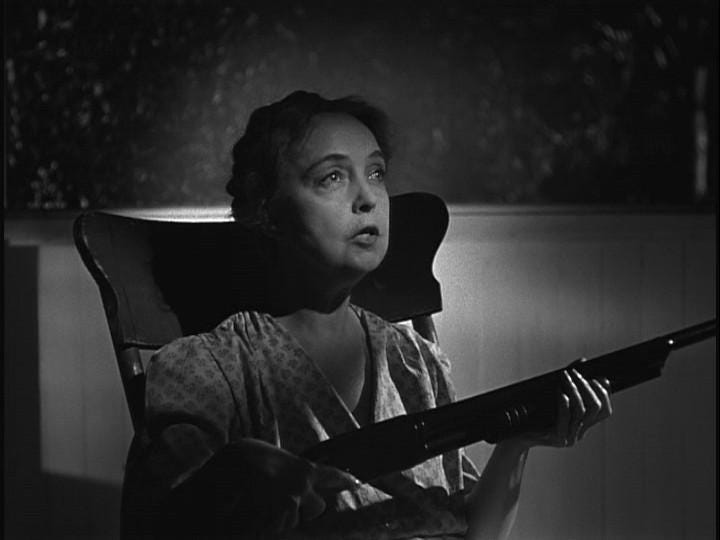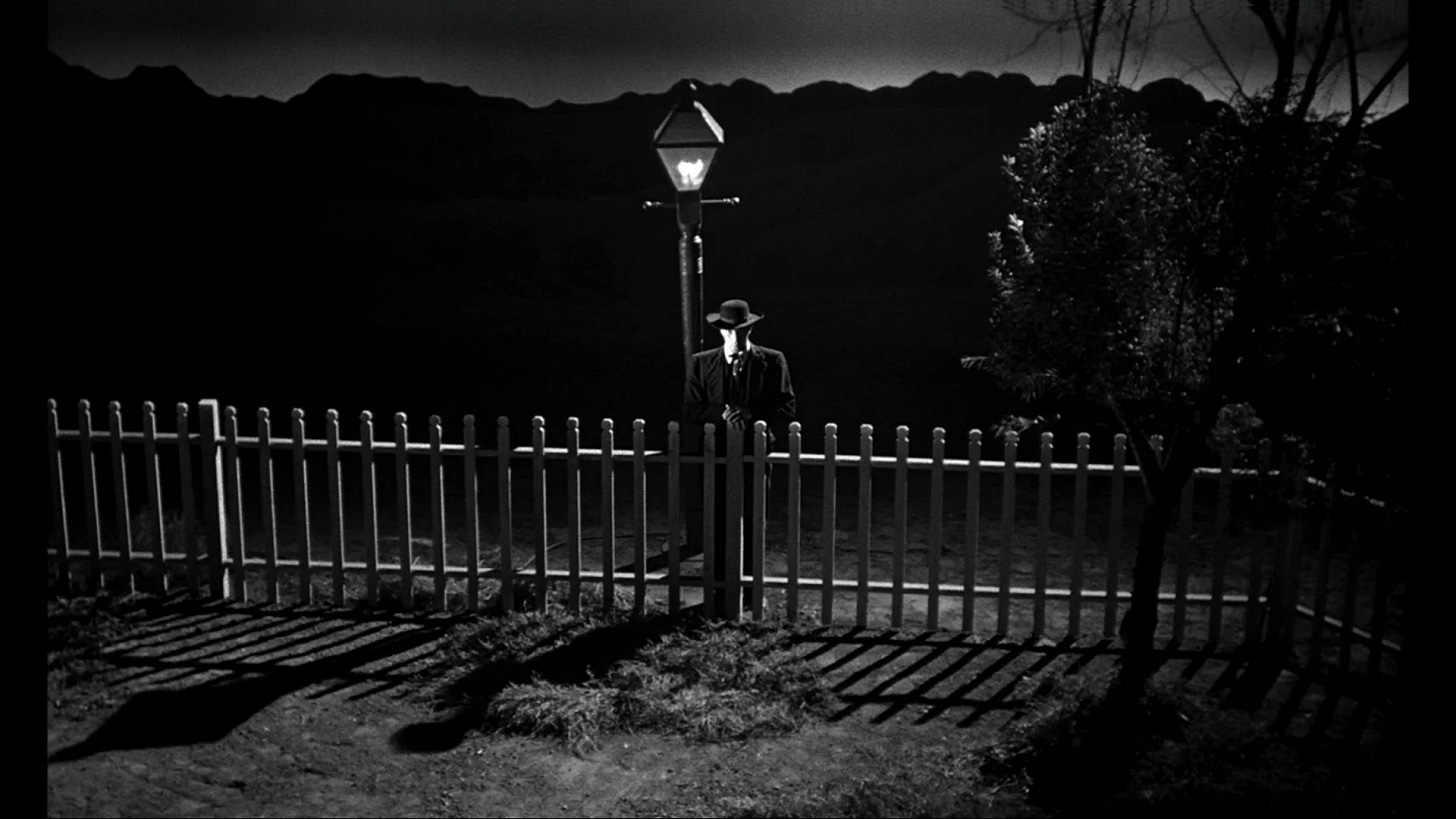To be “ahead of the times” is often the ultimate compliment for a film. It means a movie was not only a masterpiece, but something future filmmakers look to for inspiration for their own work. However, being ahead of the times is usually an albatross around a film’s neck which can last for decades until popular culture catches up with it. The Night of the Hunter (1955) director Charles Laughton’s only film was one of cinema’s masterpieces which went unrecognized for decades. The film was too vulgar, too scary, and too strange for an America that had grown comfortable with their white picket fences.
The Night of the Hunter is an adaptation of Davis Grubb’s 1953 novel of the same name. The novel was loosely based on West Virginian serial killer Harry Powers, who murdered widows to obtain their money during The Great Depression. The rights to the book were purchased by Paul Gregory, a theatrical play producer who was looking to get into the movie business. Gregory’s Broadway plays were directed by Charles Laughton, who also had a successful acting career onstage and onscreen. In 1933, Laughton’s film acting career peaked when he won the Academy Award for Best Actor for his portrayal of Henry VIII in The Private Life of Henry VIII. Gregory and Laughton were close friends outside of show business and Gregory believed The Night of the Hunter would be the perfect vehicle for Laughton to make his directorial debut. After reading the novel, Laughton enthusiastically agreed to direct the film, calling it “a nightmarish Mother Goose story”. Laughton prepared extensively during The Night of the Hunter’s preproduction phase, talking with Davis Grubb about how to adapt his novel. Grubb, an accomplished painter drew over 100 sketches of what he wanted the film to look like. Laughton was impressed by Grubb’s drawings and used them as storyboards. James Agee was hired to write the script instead of Grubb as the studio wanted someone with screenwriting experience. Agee’s experience growing up in the South and writing about The Great Depression’s effect on the region also factored into his hiring. The screenplay Agee delivered was much too long for a movie and Laughton cut it down to an acceptable length, but insisted Agee get full credit for the final script.

Charles Laughton looked to cinema’s past to help him bring the vision he had for The Night of the Hunter to life. Laughton’s screen acting career began during the tail end of the silent movie era, which by the 1950s had largely been forgotten (some 70% of silent films are now lost) with only the most famous productions like Lon Chaney’s The Hunchback of Notre Dame (1923) and The Phantom of the Opera (1925) and Charlie Chaplin and Buster Keaton’s films having any sort of resonance. Laughton in his words wanted to “restore the power of silent films to talkies” and reinvigorate what he believed had become a stale medium. "When I first went to the movies, they sat in their seats straight and leaned forward. Now they slump down, with their heads back, and eat candy and popcorn. I want them to sit up straight again." Laughton told Lilian Gish who he cast in the role of Ms. Cooper.
Cinematographer Stanley Cortez was hired to shoot The Night of the Hunter and he taught Laughton about camera lenses, angles, and lighting and what kind of emotions these elements elicited from the viewers. During their meetings, Laughton explained his ideas for the film in great detail, which impressed Cortez. Laughton was also influenced by German Expressionist films from the 1920s. The German Expressionist movement was a reaction to the horrors Germany endured during World War I and the post war political turmoil. The films explored dark themes like insanity, treachery, and alienation not seen in American films from that era. Films like The Cabinet of Dr. Caligari (1920), Nosferatu (1922), and Metropolis (1927) were all released into German theaters with hyperinflation and the rise of the Nazi Party as the backdrop. What set German Expressionist filmmakers apart from their contemporaries was their utter disregard for realism. The filmmakers were more interested in the emotions a scene provoked and leaned into creating surreal imagery. The German Expressionists intentionally confused audiences by creating sets which couldn’t possibly exist in the real world and utilizing strange camera angles. However, the use of dark shadows contrasted with bright lighting with no natural source is German Expressionism’s most unique feature and one Charles Laughton would utilize masterfully for The Night of the Hunter.

Robert Mitchum’s portrayal of Preacher Harry Powell is the glue which holds The Night of The Hunter together. It was a part Mitchum was born to play. Mitchum had a troublesome youth. He was expelled from middle school after getting into a fight with the principal and spent his teen years in the Depression hopping trains. During this time he worked odd jobs like digging ditches for the Civilian Conservation Corps and boxed professionally. Mitchum claimed he was arrested for vagrancy in Savannah, Georgia when he was 15 and was forced to work on a chain gang as punishment. Mitchum said he escaped shortly after and hitchhiked his way back to Delaware where his family was living. He later worked as a dishwasher, busboy, and a stevedore. After his sister Julie moved to California to pursue an acting career, the rest of the family joined her. It was Julie who convinced her brother to pursue an acting career as well. Mitchum worked his way up the Hollywood food chain in the post war years, first as an extra and in minor speaking roles, then in B-westerns and war films. The film noir genre was where Mitchum became a true star. His impoverished youth and exposure to America’s dark underbelly made him a perfect fit to portray noir’s dark mysterious characters. What set Robert Mitchum apart from the other Hollywood stars of his era or any era was his menacing aura which convinced audiences he wasn’t that far removed from the criminals he was playing. Even his more heroic characters were tinged with an element of danger. A 1948 arrest for marijuana possession did nothing to hurt Mitchum’s star power. It only made him a bigger star as the arrest solidified Mitchum’s reputation as Hollywood’s first bad boy.
For The Night of the Hunter, Mitchum would summon the most sinister aspects of his personality to bring Harry Powell to life. He won the role when Charles Laughton told him Harry Powell was a “desperate unconditional shit” to which Mitchum answered “Present!” However, Laughton had to restrain him from going too far with his performance, a wise decision as Powell is outwitted by a child and an elderly lady in several of the film’s most pivotal scenes, where Mitchum plays up the character’s foolishness. Laughton and Mitchum had a good working relationship throughout filming until the final week of production when Mitchum’s drug and alcohol abuse reared its ugly head. Laughton struggled to get Mitchum to shoot his scenes during this period. Producer Paul Gregrory, who admitted to being intimidated by Mitchum, tried sending him home after he showed up on set drunk one day. An offended and belligerent Mitchum responded to this demand by urinating in the front seat of Gregory’s Cadillac.
The Night of the Hunter is ultimately about good vs evil and that message is very clear from the first scene when Harry Powell drives around the countryside after killing a widow offscreen. Powell asks the Lord if he wants him to kill another one. Powell thanks the Lord letting him preach his word and for leading him to rich widows to kills and says he doesn’t mind the murders because the Bible is filled with murders. Shortly after, Powell is arrested while watching a burlesque show because his car is stolen. Powell’s misogyny is on full display during the burlesque performance as he barely contains his rage watching the woman on stage dance proactively. He puts his right hand which has the word ‘HATE’ tattooed on the knuckles in his pocket and his switchblade springs out and cuts through the fabric like an erection. It’s subtle (or not so subtle) symbolism for how Powell’s violent impulses towards women manifests itself in sexual manner.
We are then introduced to the film’s hero, 9 year old John Harper (Billy Chapin) in one of the greatest performances a child actor has ever given and his 4 year old sister Pearl (Sally Jane Bruce) who are given $10,000 by their father Ben (Peter Graves) who stole it in a bank robbery. Before he is arrested in front of his traumatized children, Ben makes them promise to never tell where the money is hidden even their mother whom Ben doesn’t believe has any sense. Ben is convicted for killing two men during the robbery and is sentenced to hang. While awaiting his execution, Ben tells his cell mate, Harry Powell he robbed the bank because he did not want to see his children go hungry like so many others have during the Depression. Powell attempts to convince him to reveal where the money is, saying he’ll build a church with it to preach the word of the Lord, but Harper refuses Powell’s advances. However, Powell finds out Harper is married and has children and when Harper is taken away to be hanged, he thanks the lord for delivering him another widow.
It's at this point when The Night of the Hunter stops being a standard noir crime drama and starts to slowly transform into a southern gothic horror film. Charles Laughton does not rely on using jump scares or graphic violence (he couldn’t have even if he wanted to) in The Night of the Hunter. The Night of the Hunter is one of the scariest films ever made because there is a never-ending sense of dread throughout the entire film, Laughton gives you the sense that’s there’s something truly evil about what we’re seeing. While looking through a shop window John and Pearl are approached by the shopkeeper, who at first is sympathetic towards the children for their loss, but quickly changes the subject to inquire where the money from the robbery is hidden. John recognizes the shopkeeper doesn’t care about them at all and takes Pearl away to visit their mother Willa (Shelley Winters) at a diner owned by an elderly couple Icey (Evelyn Varden) and Walt (Don Beddoe) Spoon where she works as a waitress. Even in the film’s earliest moments, John demonstrates bravery and heroism, particularly when it comes to protecting his sister. How children are failed by or taken advantage of by the adults in their lives is a recurring theme in The Night of the Hunter. Stephen King, who called Harry Powell one of the greatest villains in fiction would address this very theme in many of his novels like Carrie (1974), The Shining (1977), and It (1986).
Harry Powell tracks the Harper family down at the diner after his release from prison claiming to be a chaplain who befriended Ben during his time on death row and was so upset by his execution that he left the prison ministry to comfort them. Powell quickly wins over Willa, the devoutly religious Icey, and Walt by giving them a sermon about good and evil using his “Love” and “Hate” tattooed knuckles to drive the story home. It isn’t too long before Powell cons the entire town into becoming his followers. John is the only one who sees through Powell’s act, realizing he’s plotting to take his father’s money. However, Powell senses John and Pearl know where the money is.
What follows is a series of mind games Powell plays on the Harper family. He pits them against one another hoping to get one of them to reveal where the $10,000 is. At Powell’s direction, Willa pressures John to tell her about the money, but he refuses to break. When Powell tells John he will be marrying Willa, he defiantly tells Powell he’ll never be his real father and inadvertently reveals that he knows where the money is but stops himself before revealing its exact location. Willa and Powell do not have a happy wedding night. Powell refuses to consummate their marriage and tells Willa their marriage will be about raising her children and nothing more. Willa, who harbors guilt over her first husband’s death prays to be a better wife to Powell. When Willa hears Powell hurting Pearl after returning home from work, he realizes Willa doesn’t know where the money is making her expendable. Powell takes Willa to bed where he kills her and dumps her body in the river while inside his Model T. Charles Laughton’s German Expressionist influences are on full display here. The shot of Willa’s body at the bottom of the river is beautiful yet surreally horrifying. Her hair flows in the water like seaweed and she looks strangely at peace. Before she is killed, Willa lays in her bed with the light unnaturally surrounding her head like a halo and her arms folded across her chest. She’s at her funeral and doesn’t know it. There’s even a preacher present who will serve as her executioner. The bedroom is large and doesn’t match the house’s exterior and the ceiling is angled to resemble a church. The lead up to Powell cutting Willa’s throat reveals his manipulation of people is foreplay leading up to a violent climax.
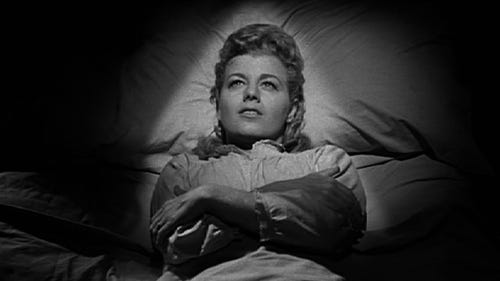
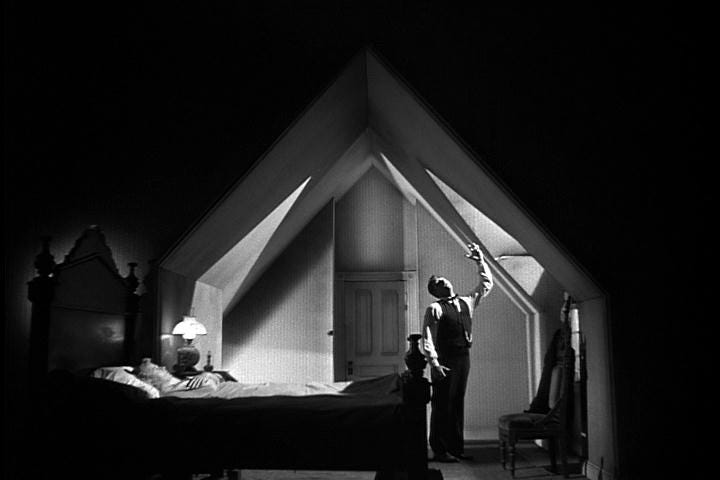
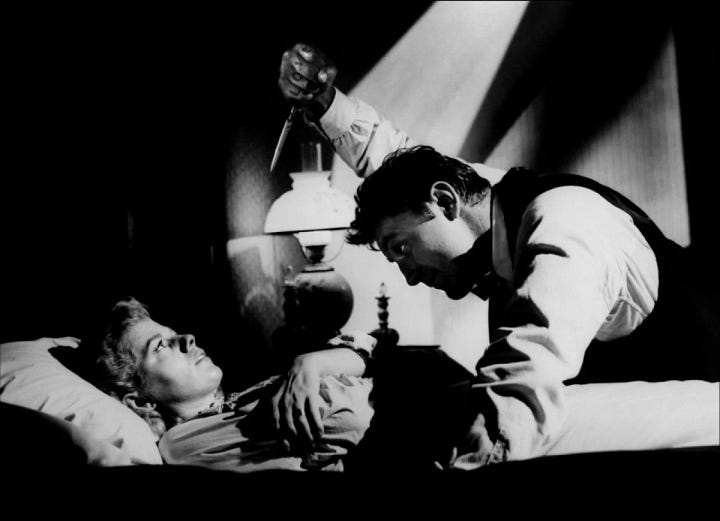
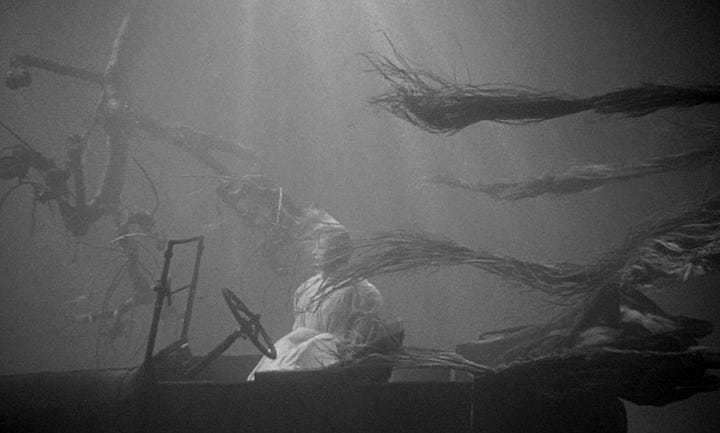
After lying to Icey and Walt Spoon that Willa has left the family due to alcoholism, Powell corners John and Pearl in the house. He bribes them with a large feast, when John refuses to budge, Powell tries to manipulate Pearl into telling him where the money is. Powell almost succeeds in getting her to break, but John reminds Pearl of the promise she made to their father, and she remains silent. An enraged Powell threatens Pearl with his switchblade and to save her life John tells him the money is stashed under a brick in the cellar. Sensing he’s not telling the truth; Powell leads the two children into the cellar where he threatens to kill John. A terrified Pearl tells Powell that the money is hidden in her doll. The children manage to escape from the preacher’s grasp when John knocks the shelf above Powell down causing a jar to fall on his head.
John and Pearl go to their Uncle Birdie (James Gleason), who earlier in the film told John he would protect him and his sister from the preacher only to find him passed out drunk in his shack. It was Uncle Birdie who discovered Willa’s body at the bottom of the river, but he doesn’t go to the police out of fear they’ll pin the murder on him. Laughton puts the audience in John and Pearls shoes throughout the film and Uncle Birdie’s failure to protect them is a terrifying reminder that the children have no one to count on, but themselves. The two children escape on Birdie’s skiff and barely escape from Powell, who comes within inches of catching the skiff in scene reminiscent of a slasher film pursuit where the slow methodical killer almost catches his intended victim.
What follows is the culmination of Charles Laughton’s nightmarish Mother Goose vision he wanted to depict on screen. As the two children float down the river with the moonlight shining on them, Pearl sings a lullaby which mirrors their journey. The sequence is interspersed with shots of a rabbit, a toad, and a large spider web observing the children’s passage. When the morning comes, John pulls the skiff on shore where they find a woman who gives orphaned children drifting through the area food to hold them over during their travels. Orphaned children roaming the countryside scourging for food while near starvation was a tragically common occurrence during The Great Depression.

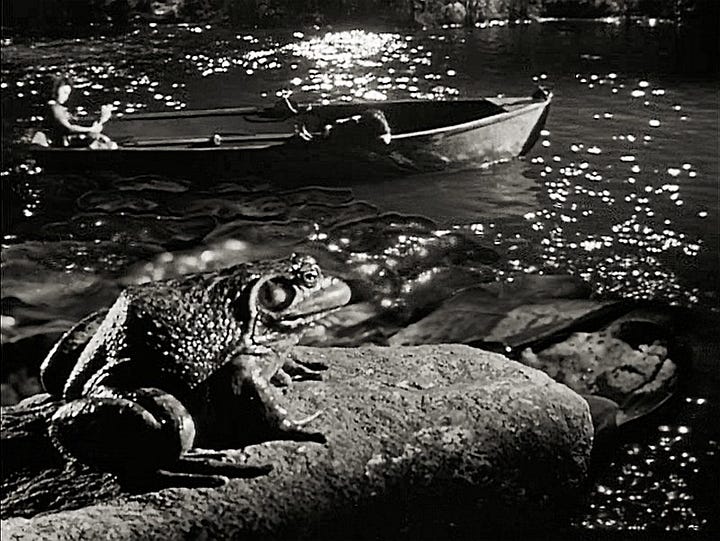
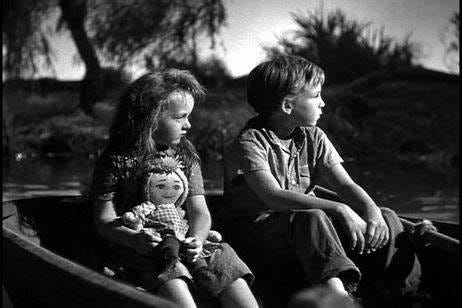
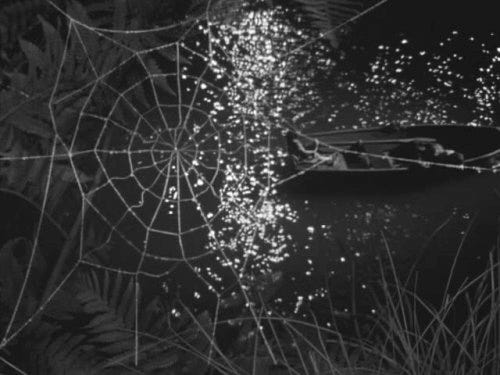
The surreal dream like sequence commences again when John and Pearl get back on the skiff. Laughton uses the break in the action to emphasize how big the world is to a small child by utilizing the wide shots of John and Pearl in the skiff with the vast West Virginia landscape in the background. Laughton also brings the camera down to the children’s eye level throughout the film to achieve this effect, a technique Steven Spielberg would utilize for his films which focused on children such as E.T. the Extra-Terrestrial (1982) and Jurassic Park (1993). When night falls, John pulls the skiff on shore and he and Pearl take refuge in a farmhouse where the audience is treated to one final beautiful visual of John looking out of the barn and into the night accompanied by Walt Schumann’s peaceful score. This moment of bliss comes to an end when John sees Harry Powell’s silhouette riding a horse on the horizon approaching the barn (an effect which was achieved by putting a dwarf on a pony). John grabs Pearl and takes her back onto the skiff before Powell spots them. Although Alfred Hitchcock’s Psycho (1960) is credited for being the first slasher film, it was The Night of the Hunter that pioneered the genre’s conventions of a knife wielding psychopathic villain who relentlessly pursues his victims and can appear seemingly out of thin air.
Charles Laughton once again defies the audience’s expectations by radically changing the film’s tone. This time taking them into a world Norman Rockwell could have painted. When John and Pearl’s skiff washes up at the end of the river, they are greeted by Rachel Cooper “Ms. Cooper” (Lillian Gish), an elderly devout Christian who has informally adopted several orphans. Ms. Cooper takes John and Pearl to her home where she bathes, clothes, and feeds them. While in Ms. Cooper’s care the children receive lessons and lectures in line with her Christian beliefs. She also preaches the virtues of discipline (Ms. Cooper’s use of corporal punishment will certainly be seen as dated by some modern viewers). Laughton pays homage to Mother Goose in several of the scenes where Ms. Cooper is the focus. When she brings John and Pearl to her home, a flock of white geese are outside and when Ms. Cooper takes her adopted children into town, they follow her like a family of geese would. The casting of Lillian Gish, the first superstar actress in American cinema was another way Charles Laughton positioned The Night of the Hunter as the spiritual successor to the silent film era. Gish starred in The Birth of a Nation (1915) the highest grossing film of its time, Intolerance (1916), and Broken Blossoms (1919). All of the films were directed by D.W. Griffith, whom Laughton studied during Night of The Hunter’s preproduction. Gish’s star faded with the advent of the sound era, and she returned to the theater where she got her initial start in show business. Her film roles would become more infrequent during the sound era. The Night of the Hunter was Gish’s first feature film role in eight years.
While Pearl warms up to Ms. Cooper, John remains distant. His experiences with unreliable adults who failed to protect his family from Harry Powell has left him jaded. Ms. Cooper wins John over one night when she tells the story of how Moses came to Pharoah’s daughter in a skiff. After sending the rest of the children to bed, Ms. Cooper has John stay behind and asks him where his parents are. John responds that they’re both dead. The two share a heartwarming moment as John takes her hand.
However, Harry Powell has tracked the children upriver where he corners Ruby, a teenage girl who helps Ms. Cooper rear the younger children at a drug store. Unbeknownst to Ms. Cooper, Ruby has been going out at night to spend time with men instead going to her sewing classes. Powell quickly charms her into revealing John and Pearl are staying at Ms. Cooper’s house and that Pearl still has her doll. When Powell leaves, Ruby realizes something is wrong and returns to Ms. Coopers house to tearfully confess that she has been going out with men instead of attending her sewing classes. Ms. Cooper does not judge or punish Ruby. She embraces Ruby and tells her she was only looking for love, a perfectly natural desire. However, Ms. Cooper becomes alarmed when Ruby tells her about the strange man who asked her about John and Pearl.
The following day Harry Powell arrives at the house asking Ms. Cooper for John and Pearl. He tries to charm her with his sermon about love and hate, but Ms. Cooper who has read the Bible frontwards and backwards has no patience for hearing a fake biblical verse and cuts Powell off asking him if he’s the children’s father. Powell claims John and Pearl are his children to a skeptical Ms. Cooper and that their mother ran off with another man during a prayer meeting. When John and Pearl are called over by Powell, John refuses to join his side telling Ms. Cooper Powell’s not his father. Ms. Cooper doesn’t doubt John for a second and says that Powell’s not a preacher either. Unlike all the other adults John and Pearl encounter throughout the course of the film, Ms. Cooper never lets them down and believes and validates the faith John places in her by believing him. Powell leaves, after getting a shotgun pointed in his face by Ms. Cooper, but vows to return at nightfall.
The final confrontation between Ms. Cooper and Harry Powell is another German Expressionist influenced nightmare. It's a battle between good and evil. A battle of wills between an elderly woman who earnestly believes in Christ’s teachings versus a man who uses the Bible as a cloak for his misdeeds. Ms. Cooper sits in a rocking chair on her porch with a shotgun in her lap while the children sleep. She is lit so only her silhouette is seen. Powell sits on a tree stump in the front yard with the moonlight shining on his face while singing “Leaning on the Everlasting Arms”, a hymn he frequently sings throughout the film to unsettle his victims. Ms. Cooper joins him in singing the song except she sings an alternate verse to show she isn’t intimidated by Powell:
“Leaning on Jesus, leaning on Jesus, safe and secure from all alarms.
Leaning on Jesus, leaning on Jesus, leaning on the everlasting arms.”
Ruby comes downstairs with a candle to check on Ms. Cooper, which distracts her from Powell who disappears under the candlelight. Ms. Cooper blows out the candle and tells Ruby to bring the children downstairs to be with her. An owl perched on a tree branch by the house spots a rabbit and flies down to kill it. Ms. Cooper remarks how it’s a hard world for little things.
Ms. Cooper stands guard over the children when they come downstairs. Powell breaks into the home, appearing suddenly on the screen giving the audience one final scare before Ms. Cooper shoots him. A wounded Powell limps his way to a shed on Ms. Cooper’s property where he is arrested the next morning by the police, who have been nowhere to be seen in the film since Ben Harper’s arrest. The police have nothing to do with Powell’s capture, only arresting him after he has left an untold amount of destruction in his path. As the police lead Powell away, a traumatized John is reminded of the time the police arrested his father in front of him. He breaks down in tears, rushes to Powell and hits him with Pearl’s doll telling him to take the money because he doesn’t want it anymore.
During Powell’s trial, John can’t bear to testify against him. Powell is convicted for Willa Harper’s murder and the murders of over a dozen other women. Icey and Walt Spoon, who fell for Powell’s preacher con the hardest attend his trial form a lynch mob and go to the prison where Powell is being held at carrying pitchforks and torches. The police sneak Powell out of the back of the prison to take him to another location, but the prison hangman reminds Powell that he’ll be seeing him soon.
The film ends on Christmas Day with Ms. Cooper’s adopted children opening their presents. Ms. Cooper gives a sermon to herself marveling at how children endure and abide in a harsh and cruel world as John admires the watch he’s been gifted. The nightmare is over. Powell’s sermon about good ultimately winning over evil turned out to be true even though he didn’t believe in it.
The Night of the Hunter doesn’t fit neatly into a defined genre. It defies genre. The Night of the Hunter is a noir, a southern gothic horror film, a family drama, and heavily influenced by Christian teachings. It also pioneered the slasher subgenre of horror films which became popular in the 1980s after John Carpenter’s Halloween (1978) was released. Alfred Hitchcock’s Psycho (1960) is considered by film historians, critics, and fans to be the first true slasher film even though The Night of the Hunter was released a half decade earlier. Although the film initially divided critics, unlike The Night of the Hunter, Psycho was a box office success and immediately became an iconic foundation of popular culture. Nobody in 1955 knew what to make The Night of The Hunter. The film received mediocre reviews from baffled critics, and it was a commercial failure. The movie going public of 1955 didn’t want to be reminded of the crushing poverty they endured during The Great Depression and depicting a preacher as a con artist serial killer only further soured people on the film even though Ms. Cooper embodies all that is good about Christ’s teachings. The Night of the Hunter being shot in black and white also hurt the film at the box office because audiences were demanding to see more movies in color. United Artists’ promotional campaign faltered because they were unsure of how to market the genre defying film. Laughton was disheartened by The Night of the Hunter’s lackluster reception and returned to directing and starring in plays. He would never direct another film. Laughton died from renal cancer on December 15, 1962, at the age of 63. He never lived to see The Night of the Hunter become regarded as a masterpiece of America cinema.
The Night of the Hunter’s journey to becoming a classic unfolded over several decades. The film garnered a cult following when it was played in museums and art houses for film aficionados who appreciated its cinematography. In the decades since, the film critics who grew up watching The Night of the Hunter wrote articles in magazines and newspapers reassessing the film giving it rave reviews to their readership. Robert Mitchum’s enduring stardom undoubtedly helped The Night of the Hunter as fans of his work sought out his performances and saw that Harry Powell was the best character he ever portrayed. As of this writing The Night of the Hunter has become an easily available film on free streaming services like Tubi which has widened its reach in the 21st Century. Martin Scorsese, the director of Goodfellas (1991) and Raging Bull (1980), William Friedkin, director of The French Connection (1971) and The Exorcist (1973), Spike Lee, The Coen Brothers, and Guillermo del Toro have all cited it as an influence on their careers. Spike Lee paid homage to the film in Do the Right Thing (1989) which features one of the main characters, Radio Raheem wearing brass knuckles with “Love” and “Hate” inscribed on them reciting a sermon identical to the one Harry Powell gives. In 1992, the Library of Congress selected The Night of the Hunter to be preserved in the National Film Registry due to its cultural and historical significance. The American Film Institute (AFI) ranked The Night of the Hunter as the 34th most suspenseful film ever made on their 100 Years…100 Thrills list in 2001 and in 2003, Harry Powell was ranked as the 29th greatest villain of all time on the AFI’s 100 Years...100 Heroes & Villains list. Unfortunately, Lillian Gish and Billy Chapin’s performances have gone unrecognized. Their performances are every bit as incredible as Robert Mitchum’s and the characters they portray are just as heroic, maybe even more heroic than Kirk Douglas’ performance as Spartacus or Jodie Foster’s performance as Clarice Starling.

Robert Mitchum never analyzed the films he appeared in nor the characters he portrayed. While he did not shy away from being a celebrity, Mitchum approached acting like every job he had had before breaking into the movie business. It’s telling that the only film of his own Mitchum went out of his way to praise was The Night of the Hunter. He said The Night of the Hunter was his best film and went as far as to say that Charles Laughton was the best director he ever worked with in an interview he gave decades after the film’s release. In the same interview, Mitchum lamented that Laughton only ever directed one film. However, that might be for the best. It would have been impossible for Laughton to follow up The Night of the Hunter and the fact he never directed another film only strengthens both his and The Night of the Hunter’s legacy. Next year will mark The Night of the Hunter’s 70th anniversary and the film’s tale of good vs evil will always be timeless while its hauntingly surreal cinematography and atmosphere still captivates audiences. Perhaps Charles Laughton and The Night of the Hunter will forever be ahead of the times.





